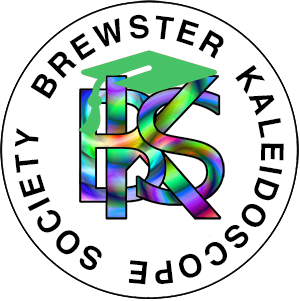19th Century American Kaleidoscope Artist
Charles Gustavus Busch (1825-1900)
by Mary Theresa Boll
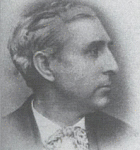
Charles Busch was born on June 6, 1825 in Colberg, Prussia to Heinz and Charlotte Busch. Colberg, Prussia is a small port town on the Baltic Sea which was renamed Kolobrzeg and became part of Poland after WWII. Busch attended school there until he joined his father’s business as a rope-maker. In 1846, he married Emilie Wilche Later in December of 1846, his only child, Maria, was born.
In 1847, he, his wife and daughter immigrated to the United States. Their first home was in Plymouth, Massachusetts where Busch established a successful rope-making business. In the 1850 census, he is listed as living in a boarding house in Plymouth, Massachusetts. In August of 1860, he is living in Boston with his wife and daughter. His home was worth $2,600 and his personal estate was worth $300. This amount today would put him in a comfortable income category. On September 26, 1860, he became an American citizen. In 1867, Maria, his only child, would marry James Piper, a farmer sixteen years her senior and in a few years they would have two children.
“Early in his business career, (Charles Busch) began the use of the microscope to examine the fiber of his rope material, and this fact had a great bearing on his later life. As a microscopist he became famous, and acquired a facility in manipulating the instrument to bring out its full power that was wonderful. For a time he was assistant to Professor Louis Agassiz, and he was the corresponding secretary of both the Boston and New York Microscopical Societies.
His energy did not expend itself in a single direction. His enthusiasm for the microscope led him to study the construction of telescopes, of kaleidoscopes, and to become a most expert photographer.
His interest in these various instruments led him to give up rope-making and to become a manufacturer of kaleidoscopes. He manufactured the instruments by thousands and those of his make were preferred in all markets. Even after his removal to Claremont in 1875, he continued their manufacture, and made over 5000 of them in a little room of his home in Bible Hill.”
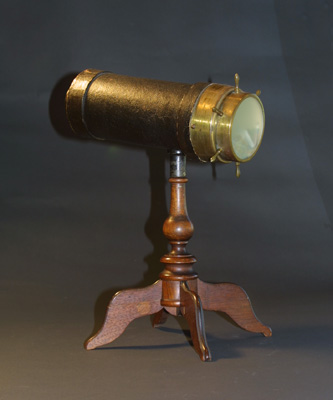
It was in the early 1870s that he began developing kaleidoscopes. Bush manufactured his parlor kaleidoscopes by the thousands and they were recognized as extraordinary even then. These instruments had a barrel of black hardboard with a spoked brass wheel rotating an object cell, mounted on a turned wooden stand.
Most noteworthy about the Bush kaleidoscopes were the glass pieces contained in the object case. Bush had a basic mix of about 35 pieces, a third of which were liquid filled. Inside the liquids were air bubbles that continued to move even after the object case was at rest. Both the solid and liquid-filled glass pieces were of brilliant and well-chosen colors, and the patterns they formed were the finest of any 19th century kaleidoscope. One unusual piece that comes into view in a very few of the original Bush scopes is a clear glass disk embossed with a swan. But it is the liquid-filled ampules that are by far the most distinctive feature of the Bush scope.
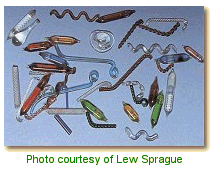
While Bush has been given credit for the first liquid-filled ampules, there is mention in Brewster’s original 1819 treatise that “differently moving fluids enclosed and moving in small vessels of glass will make the finest transparent objects for the kaleidoscope”. That explains why a few such objects can be seen in some early European scopes.
Bush secured several patents in 1873 and 1874; the first for a new and useful object for the object box – hermetically sealed liquid-filled ampules; the second for a means to add and subtract pieces from the object case without having to disassemble it; one for the use of a color wheel as a backdrop for the images; and another for a four-legged wooden stand that could be disassembled for easier carrying and shipping. (Cozy Baker, Kaleidoscope Renaissance, 1993, p 19-20)
In 1875, he and his wife went to live with their daughter and son-in-law in Claremont, New Hampshire. His daughter, Maria, was the only one allowed to help him with the kaleidoscopes that he made on Bible Hill Road in Claremont. In the 1880 census, Busch is listed as a retired chemist. In 1885, Busch and his wife traveled to Germany for a visit.
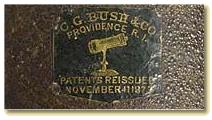
It was only on his kaleidoscopes and patents for his kaleidoscopes that he used the name C. G. Bush, dropping the “c” from his last name. In all his other correspondence and official documents, he continued to use Busch, the German spelling of his name. Occasionally his middle name was also anglicized to Augustine so his middle initial will be seen as an ”A” at times.
In March of 1897, his wife of over fifty years died. Then in October of the same year his son-in-law, James Piper, also died. His daughter sometime in the next two years sold the farm and he and his widowed daughter moved to Greenville, Massachusetts. In May of 1900, Charles Busch came to Claremont, Vermont to complete the packing and disposition of his workroom items at the farm. Within a day of arriving in Claremont, Charles Busch became ill from pneumonia and died four days later on May 19, 1900. He was buried beside his wife and son-in-law in Claremont, New Hampshire.
